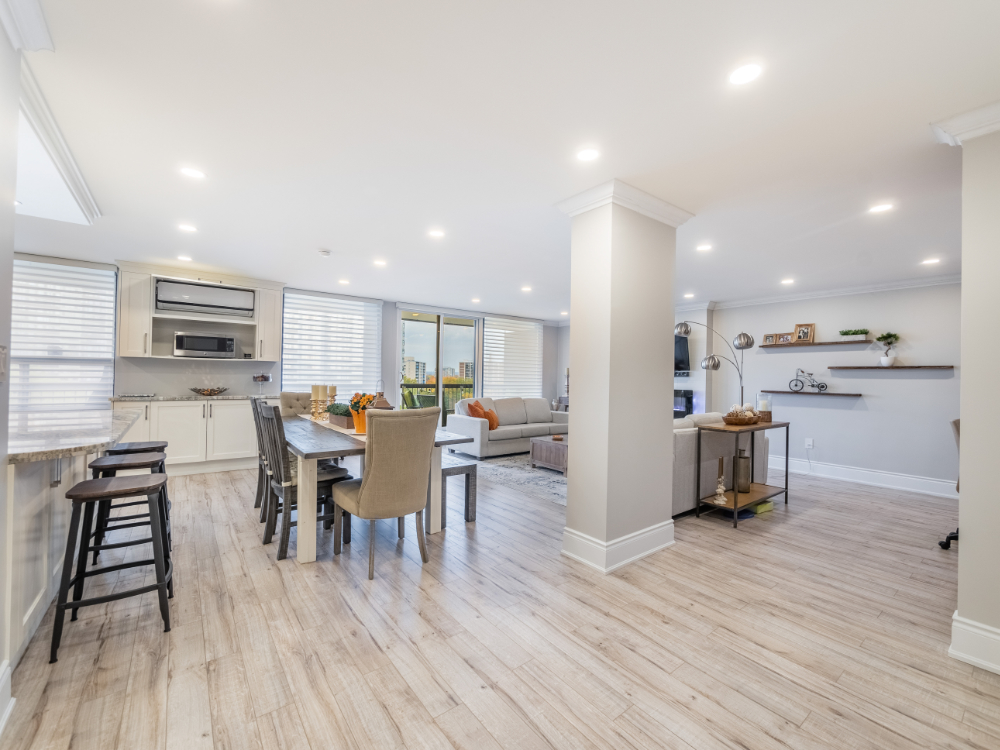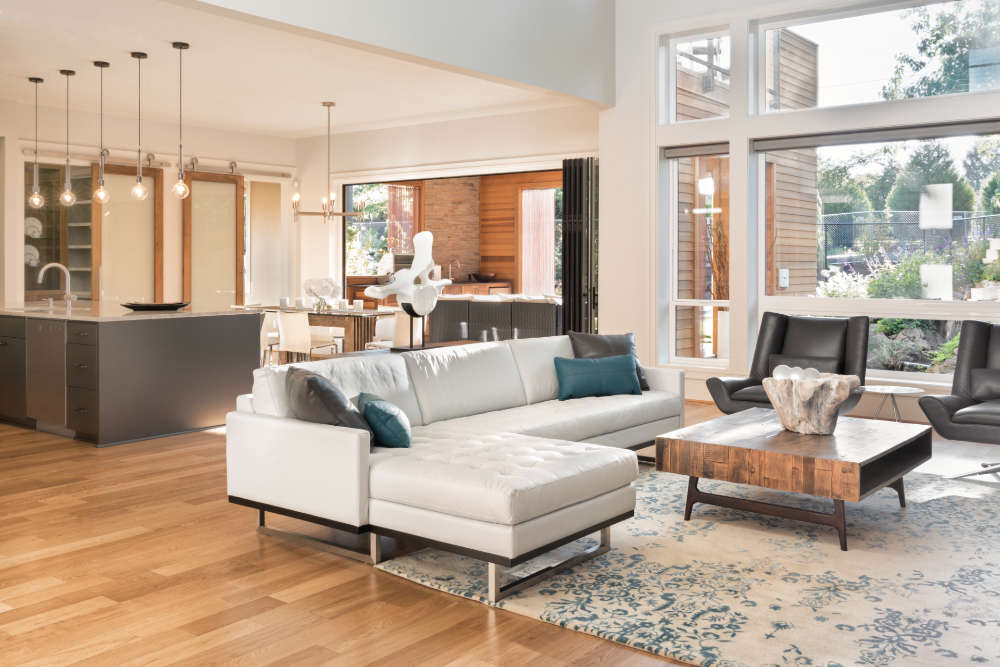If you are planning or at least considering a remodel, a spacious open floor plan layout is likely to be at the top of your wish list. And it’s not hard to understand why. Open concept kitchen, living, and dining areas create a beautiful modern esthetic and the spaciousness gives it a relaxed feel. Open floor plan rooms may seem easy to decorate, but they can actually be quite challenging due to their lack of defined borders.
While there are haters of the open floor plan, I can’t remember the last time a saw a layout for a condo that wasn’t an open floor plan. In a small space, it is downright unpleasant to have separate little rooms with no natural light.
When they build condo units that are 500 square feet these days, they would have a hard time selling them with a kitchen separated from the living room. An open floor plan just has a relaxing luxurious feel that sells.
Here are some common mistakes people make when going with an open concept floor plan – and how you can avoid them in your interior design.
1. Zoning in an open floor plan
It is essential to divide open floor plan spaces into separate areas, such as cooking, eating, and relaxing, in order to make them functional and visually appealing. An open-plan space is divided into different zones that function as individual “rooms.” However, the zones should have a feel of visual continuity.
The anchor points that tie the individual areas of an open-plan space together are often overlooked. This can create the illusion that an open plan space is a big hall.

Simple fix – interior design tip:
If you move the sofa across the room, you can separate the room into two sections. The living room will be better defined with a rug under the couch and a floor lamp or a table lamp beside the sofa. Consider using the same flooring throughout the kitchen, the living room, and the dining room to create a sense of continuity.
2. Excessive variety of styles
An open concept floor plan can be easily over complicated by mismatched furniture and decor items. When you design an open floor plan space, you should ensure that different aspects are cohesive, meaning they complement one another without trying too hard.
Choosing an open concept style you love and that matches your decor is a simple fix. Pick interesting furniture and accessories with varying colors and materials, yet at the same time still communicate visually (such as varying shades of the same color).
Rooms with an open layout tend to be noisier than rooms with closed doors. Consider adding softening elements to your room such as curtains, rugs, and throws to reduce noise levels.
3. Lighting strategies for an open floor plan
In many interior design projects, lighting is overlooked as a major influence on mood. It is generally located too far from where it is actually needed. A large open space has difficulty achieving an atmosphere within each individual portion. When lights can’t be dimmed or have an individual control, it can be even more difficult to create an atmosphere.
We recommend beginning the project with an understanding of lighting and electrical elements. Be mindful of where furniture is placed and the placement of lighting. The floor may need to have an electrical outlet if, for example, the sofa is in the middle of the room. You don’t want to have a long extension cord running from the middle of the room to the wall.
As you plan for elements like electricity, lighting, and television connections, you should bear in mind the fact that there are fewer walls between your kitchen, living area, and dining room than there are between separate, isolated rooms.
4. A kitchen that does not fit the space
The kitchen can look completely disconnected from the architecture of the house or the adjoining living room in open-plan spaces.
Remedy: The kitchen should be integrated into the overall architectural and design scheme of the home to connect it to the living area. You should consider the design era of your home and the decor in the adjoining rooms when selecting elements for your kitchen, such as colors, cabinet styles, countertop materials, and backsplash materials.
You can give your living and dining spaces a sense of cohesion by utilizing the same colors and finishes throughout.
5. Large Pieces of Furniture
An open-plan space can seem cramped and difficult to pass through with furniture that is too large. For maximum efficiency, pathways should be between 35 and 40 inches wide.
Consider this: Before buying furniture you should make sure it will look good on a floorplan and will give you more space to move. You might consider having custom-made pieces made to fit the dimensions of the open-plan room if it is small and you can’t find furniture to fit.
You can also find furniture that doubles as a coffee table and storage, saving space, such as a large, round ottoman.
6. Maintaining the status quo
The old furniture and decorating ideas often accompany people when they downsize and move to an open-plan apartment. Open-plan layouts are very different from closed-off rooms, and some people don’t take into account the fact that the space could be smaller than they anticipated.
Despite the fact that kitchens, living rooms and dining areas are now integrated into one space rather than separate rooms, people often use the same color schemes in these rooms as they did in their old home. Because of this, the new space might feel crowded and uninviting, and decor may clash.
As an alternative to replicating the look of your previous home in your open-plan home, try looking at the new area from a different perspective. To create an open and airy atmosphere, start by painting the walls in the living, dining and kitchen areas a neutral color. This will create a sense of flow between the spaces. For the finishes and furniture in the three areas, add one or two complementary colors in varying strengths and shades.
7. Improper furniture placement
Open floor plan spaces tend to have a lot of furniture positioned improperly. Basically, you must adhere to decorating rules. A room that opens onto the living area has its own decorating rules compared to a closed-off room. A sofa and storage unit, in the past, would have been pushed against a wall to maximize usage of space. A space with an open design may feel cold and sparse if you do this.
Make the most of your open living space by being open-minded about where you place furniture (such as the sofa, which is often the centerpiece). Ideally, you should put it somewhere without a wall behind it, such as the middle of the room. As an alternative to the traditional three-piece setting, consider having two sofas opposite each other, or one sofa and one armchair. In the process of choosing a new sofa, see if one with a low back can offer you an uninterrupted view of the entire room.
Consider simplifying existing furniture to make it feel less cluttered if you plan to use it. If you have limited space, consider switching out a few pieces. Instead of a second sofa, you might opt for a slender armchair or two, or consider compact side tables instead of a large coffee table.
8. Overuse or underuse of different materials
An open floor plan room requires a delicate balance between types and numbers of materials, which a lot of people miss. The room will often look cluttered and unfinished thanks to the overuse of different materials and finishes, or it could even appear dull and bland because of not using enough. Ideally, an open-plan space should feel cohesive and simple in aesthetics, but also interesting in functionality.
Look for open floor plan ideas…
The key is space planning. Prior to decorating, look for open floor plan ideas, spend some time arranging the space and seeing how it will work. You can begin with a plan, then move on to a perspective view or a three-dimensional model. A room that is open floor plan should generally use a maximum of five finishes, and no fewer than 3.
Consider creating a balanced look when selecting finishes. In the dining and living areas, for example, balance out hard materials, such as stone, in the kitchen with curved surfaces and warm materials, such as wood.
If you do not love styling your open concept space, avoid open shelves.
Also check out 6 Luxury Home Must-Have Items

